Have you heard of the toilet rough-in measurement before? If yes, then you must have known that Rough-In is the exact distance between the toilet flange and the back wall.
So why is it so crucial for the bathroom ambiance? The answer is that if there is not enough clearance, it might disrupt the dismissal of waste and cause a weird clogging problem. But most people are not aware of this phenomenon. For a better understanding, this article will compare two of the most common types of rough-in, which are 10-inch and 12-inch rough-in. After going through the article, you will be able to make the decision by yourself about which is the best and why.
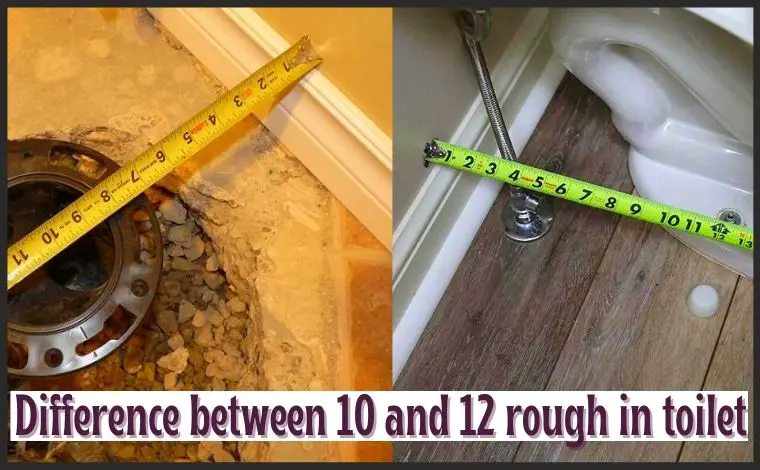
What Is a Toilet Rough In?
Toilet rough-in is one of the most crucial elements before installing a toilet in your home or office. The rough-in is simply the distance between the toilet’s backside wall and the toilet’s base nut. You may have found lots of types of rough-in dimensions in the market, but there is always a discrepancy in whether you need the right measurements for rough-in. If your rough-in measurement is not the same as the demand for your bathroom toilet, then the toilet will not fit into the bathroom, and all of your money will go into the vent. The most crucial thing you can ever find in installing a new toilet is the exact calculation of the rough-in.
The toilet rough refers to the location of the waste disposal outlet in your toilet. The rough-in can either be on the floor or on the walls. A typical rough-in is the distance from the center of the toilet to the wall behind it. Knowing the measurement of your rough-in is a key factor in designing any toilet. But that’s not all. In this article, we’re going to discuss rough-ins and their technicalities. Toilet rough-in dimensions represent the distance between the center of the outlet drain and the wall behind your toilet. It’s important for two specific reasons: installing a new toilet depends on the rough-in. If you can minimize the rough-in, you can free up space in your toilet room. But why would you measure the toilet rough-in? You probably do it because you want to replace the old toilet and install a new model.
3 Different Types of Toilet Rough-In
There are varieties of rough-in measurements that you can implement in your bathroom toilet. Not all the calculations are suitable for your bathroom, so you need to be prudent enough to choose the exact toilet measurement. Here I am discussing some of the best and most authentic rough-in measurements for the bathroom, so let us explore those tremendous types of rough-in,
10-inch Rough-In:
This is not the most popular type of rough-in for the toilet, and it is mainly suitable for the older and ancient toilets that need only a tiny little space to cover up the space. You can mostly find these types of rough-in in traditional old homes. The weight of the demerits is heavier than the advantages. In this rough-in, you will find scanty space for rearrangements and for repairing works; it is more dust-prone and claims a lot of blockage in the system. But the main advantage is that it is perfectly necessary for the small bathrooms. Its compactness is really applaudable. 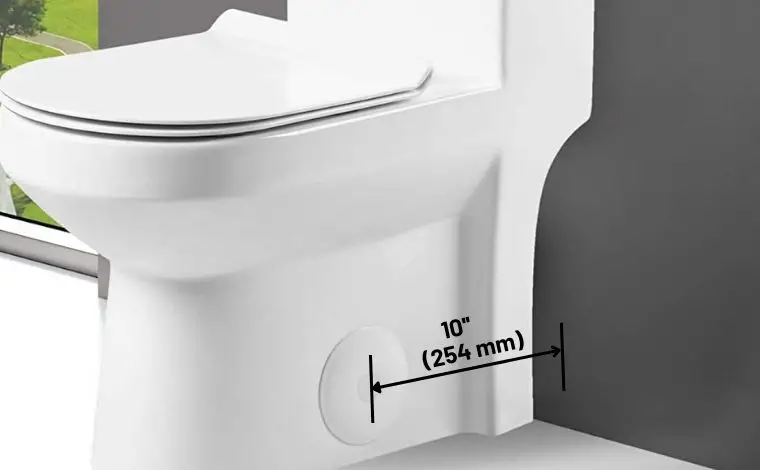
What are the pros and cons of 10 Inch Rough-in toilets?
There are lots of considerations before implementing the 10-inch rough-in measurement in the bathroom. You should have known some of this measurement’s hidden pros and cons. Let us witness some awesome pros of this 10-inch rough-in,
Advantages:
One of the prime merits of the 10-inch rough-in is its compactness, as it takes only a small space in the bathroom and is ideal for those with a very limited amount of space. Another most conclusive benefit is that it is convertible to the 12-inch rough-in, which is a colossal feature. It’s dynamic and understands the space-saving technology in the bathroom.
Unavoidable setbacks
The harsh truth is that this type of rough-in is not suited for the latest toilet models, compared to those toilets w This toilet is more prone to dust, dampness, rustiness, and humidity as it is located actually very close to the water supply elements. When you are up to doing any type of repairing work, it makes your work more complex as there is a very sparse space behind the toilet. It is also prone to acute clogging as the space around the toilet is too scanty. Another disadvantage is that this rough-in type is very costly compared to other types of rough-in.
12-inch Rough-In:
The most popular type of rough-in available in the market is the 12-inch Rough-In. The main reason behind the popularity of this rough-in is because of its universality and versatility. It can be fitted in almost any kind of modern toilet, whether it is small or spacious. It doesn’t matter, and it can adapt to all types of calculations. Since it’s the most common, people assume their toilets to have a 12-inch rough-in. However, we recommend measuring thoroughly before getting one. So it is more prudent and safe to have a 12-inch rough-in in your bathroom. 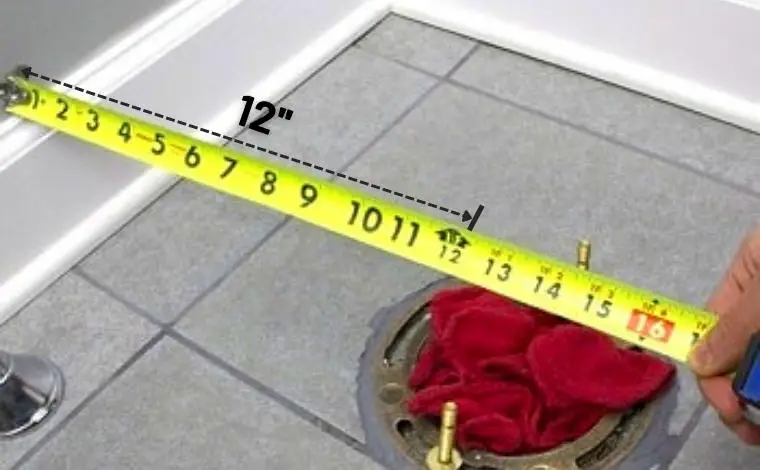
Advantages and Disadvantages of 12-Inch Rough-in toilets:
Now, let us talk about the latest and hottest type of rough-in, which is the 12-inch rough-in. It is compatible with the latest and modern generation, and the colossal merits will blow your mind. Let us have a closer look Into the tremendous features of the 12-inch rough-in,
Pros
One of the main staggering features of this rough-in is that it is compatible with almost all types of bathrooms, whether it is small or large. It is less prone to dampness, sweating, and humidity as it occupies a healthy amount of space all over the toilet. It has stronger flushing power, and anyone can use it with sheer ease and comfort. And another tremendous aspect is that it is pretty much affordable as it comes in a budget-friendly manner. It is the most used rough-in all over the globe.
Cons
The main demerit is that it can not be converted into a 10-inch rough-in as it is not a dynamic type of rough-in actually.
14-inch Rough-In:
Unlike the 12-inch rough-in, the 14-inch rough-in is not that well known in the vicinity. It is not that traditional for modern toilets. The main advantage of this type of rough-in is that it provides a lot of space and clearance in the bathroom territory. Nonetheless, it is the least preferable option among all other rough-in measurements.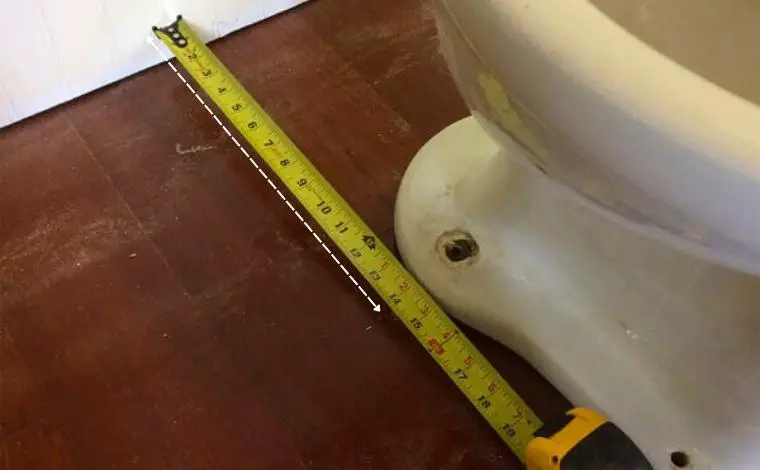
Major differences between 10 and 12 rough in toilets
For a long time, it has been bursting on the internet; which one is the better rough-in? We will perform a parallel comparison between these rough-ins to understand this better. Let us pick up some points of comparison and discuss the compatibility between these two,
Difference-1: Versatility at its best
The 10 inches rough-in is generally found in older and shabby houses, while nowadays, the 12-inch rough-in is considered the standard size. The 10-inch rough comes with a lot of narrow versions. On the other hand, 12-inch rough toilets possess a lot of options. You can find them in a variety of choices like a one-piece, two-piece, elongated or round, and standard or chair height. Some of them may possess water-efficient performance.
Difference-1: Toilet clogging
The most unconvincing thing about the toilet is the acute clogging problem which is quite often in the 10-inch rough-in. As the distance between the flange and back wall is quite scanty in the 10-inch rough-in, it is obvious to be clogged any time soon, and the trapways are also smaller than the 12-inch rough-in, which is another cause of acute cloggings.
Difference-3: Performance and compatibility
The 12-inch rough-in is made to inaugurate the king’s throne as it is best compatible with any type of bathroom. The wide varieties can make a difference. The 12-inch rough-in is made for a superior purpose. The performance is always up to the mark; undoubtedly, it is more durable than the 10-inch rough-in.
Difference-4: Water consumption
One thing that is going to be more scanty and unavailable in the near future is freshwater itself. So the demand for less water-consuming products is always high in the market. People nowadays search for those products which consume the least water as it saves some of their precious water bills.
Before the invention of the water-saving toilet modules, people had to buy traditional toilets, which consume more than 2 gallons of water per flush. And in the long run, the water bills were soaring to the sky. But thanks to modern science and invention now, the spiky models consume less than 1.28 GPF of water. And the bottom line is that the 12-inch rough-in toilets use less than 1.28 GPF of water, so it is the clear winner in the case of water consumption.
Difference-5: Design and appearance
The 10-inch rough-in toilets are out of fashion nowadays. The sleekest and most advanced type of design that you find today is mostly the 12-inch rough-in toilets. They are the standard measurement and can cope with any bathroom ambiance. The design and aesthetics are truly unsurmountable, so if you are an aesthetic freak, no other option is better than the 12-inch rough-in.
Difference-6: Pricing factor
The biggest and countable aspect before buying any product is examining the price tag of that particular product. I can assure you that the 12-inch rough-in is less costly than the 10-inch rough-in, and the main reason behind this is the availability of the products. The 12-inch rough-in is much more available in any nearest market or online platform than the 10-inch rough-in. So if you are searching for a budget-friendly rough-in, then you must go for the 12-inch rough-in.
Short summary: Point of comparisons
| Compare | 10-inch rough-in | 12-inch rough-in |
| Water consumption | More than 2 GPF | 1.28 GPF |
| Compatibility | Older toilets / Small toilets | Contemporary toilets/ Spacious toilets |
| Clogging issue | Very prone to acute clogging | Clogging is not prominent here |
| Pricing factor | Expensive than other rough-in | Budget-friendly/ Less costly |
| Durability | Less durable | More durable than 10-inch rough-in |
How to calculate the actual size of the toilet Rough-in?
Look, measuring the rough-in is a technical thing to do, and it needs a lot of prudence to perform the rough-in measurement. But there is nothing to worry about because, in this article, I am going to elaborate on the total steps to perform a rough-in measurement.
Tools needed to measure rough-in:
- Measuring Tape
- Basic hand tools
- Scale and Wrench
- Nuts and bolts
Step-1: Measuring the distance from The Toilet Flange to the Back Wall
The main measurement of the rough-in must be started from the toilet’s back wall to the toilet’s central flange, which is the exhaust drainage line. You need to have a decent measuring tape for accurate measurement. A flange covers the drainage pipe’s upper rim, and it is used to keep a strong airtight relationship between the toilet and the exhaust drain. Then attach the hook of the measuring tape to the wall that is situated behind the flange. Pull the length of your measuring tape out and stick the hook flush against the bottom of the wall behind the flange.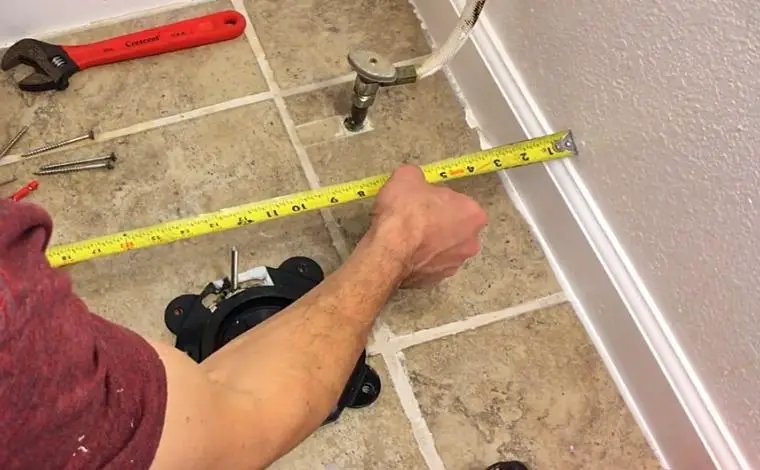
If a baseboard or trim is at the lower portion of the wall, Uphold the hook until it is on the drywall. Then make the hook steady with the existing hand. If the wall is unfinished, stick the hook against the joist at the bottom of the wall. Finally, measure the rough-in, which is related to the distance from the wall to the center of the flange. Then locate and identify the distance from the hook to the flange’s center and find the flange’s center on the particular measuring tape. Toilets you are using at home never sit flush against the baseboard unless they are commercial toilets. The respective calculations for rough-in often ignore obstacles at the bottom of the wall.
Step-2: Measuring from The Center of The Toilet to next to the attachments
In simple words, the next measurement is from the center of the flange to the left and right sides of the toilet. When you are using the toilet, you need to sit in and spare your legs on both sides of the toilet. You need to provide some space for your toilet. So, you need to keep at least 15″ clear on its sides. So, from the center of the flange, measure to the closest fixtures on its left and right. If you don’t have anything on the side, measure the distance between the nearby walls. Similarly, take the measurements of drywalls, mosaics, or stud walls into account. If you have any renovations planned for the future, consider that also. Otherwise, something as simple as the long arm angle could take up too much space. Making the toilet unusable. 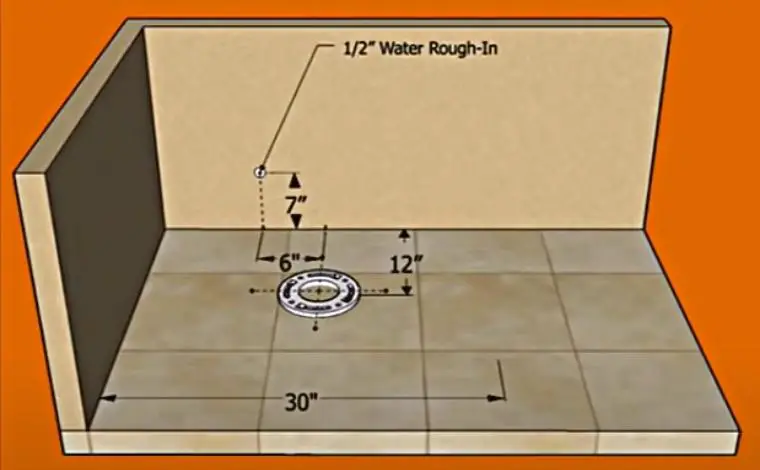
Step-3: Measuring From The Front to any impediments
There should have been some other kinds of bathroom accessories beside or adjacent to the main toilet, like the bathtub, shower, bathroom sink, simple cupboard, casings, washlet, bidet, and many more elements. Having a decent amount of free space from these accessories is crucial. Otherwise, you won’t be able to use the toilet freely. If a tub or vanity is blocking and obstructing the way to the wall, locate the particular hook on that instead of the wall; if you initiate on the left or right side. So be prudent before installing any toilet in your bathroom.
Step-4: Calculating the bowl size of the toilet
Another thing that is a must consideration for the rough-in measurement is the actual size and shape of the toilet bowl; the bowl could be rounded shape, or it could be elongated in shape. Whatever the shape on the front side, there should be a minimum and at least a 21″ distance or a maximum of 24″ inches from the front side if there is a scanty space in the front.
Pull it out on your measuring tape until you reach 21 inches. Start your measurement by pulling your tape 21 inches out from the center of the flange. The minimum amount of room that you need for the average person to sit comfortably on a toilet is 21 inches. Depending on where you live, it is also typically against building codes to install a toilet with less than 21 inches of clearance in the front
How to replace 10-inch Rough-in with a 12 Inch Rough-in?
The 10-inch rough-in is not considered the best one from the perspective of today’s juncture, but one of its biggest advantages is the ease of converting it into a 12-inch rough-in. It is simply done by installing an extra offset flange that attaches the toilet flush outlet to the primary exit drainpipe. A toilet flange is actually an adaptor that makes it possible to transfer the rough-in. The flange is also open to the change of its actual directions. Keep in mind that when you are installing the flange, it should be one-fourth inches above the floor to create ample space when pressing the wax ring, and it can create a tight seal in the toilet.
How to install the Offset Flange?
The main thing you need to do when converting the rough-in is to install a brand new offset flange, and let’s see how it is done. First, You need to measure the drain opener that is 3 or 4 inches wide. Then arrange an offset flange compatible with the rough-ins size. The right size wax ring and bolts are also a must to create a tight seal. Then turn off all the water supply lines that are connected to the toilet. Flush the water from the tank and soak the remaining water with the help of a soft sponge. Then remove the old toilet and place it in a soft cotton cloth or foam. Take out the worn-out wax ring and clear the sections over the base. Then unbox the new flange and prepare it for installation.
Now place the new flange in the exact position and add the wax ring and bolts to make it stable. After all the operations, you need to turn on the water supply line and flush the toilet. That’s how you can convert your toilet from a 10-inch rough-in to a 12-inch rough-in toilet.
10 Inch vs. 12 Inch Rough-in Toilet – Which is the winner?
Now here is the million-dollar question. Which is the better rough-in? Is it the 10-inch rough-in, or is it the 12-inch rough-in? If you have read the article with sheer determination, then you have probably found the answer. The 12-inch rough-in is a clear winner in terms of usability and versatility. It is miles ahead of the 10-inch rough-in in terms of design and aesthetics, versatility, price mark, and everything you need to satisfy your bathroom ambiance. So if you want to add an extra flavor of modernism, then undoubtedly go for the 12-inch rough-in and thank me later.
Hi, this is Robert Crossan, the owner of this website, has 17 years of experience in the installation, maintenance, and repair of toilets and plumbing systems. After completing the Level 2 Basic Plumbing course in 2005, I started working in both domestic and commercial buildings as a professional plumber. So I can figure out the core difference between different toilet models and brands. It also helped me monitor their work performance and setbacks.